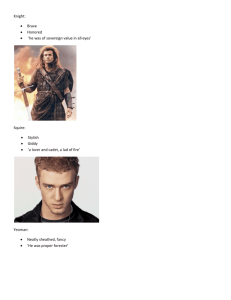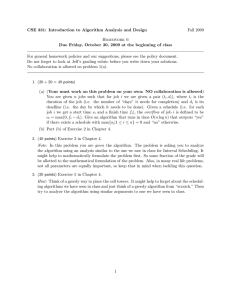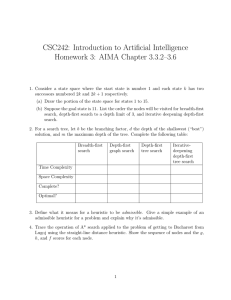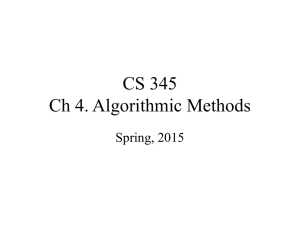The number of depth-first searches of an ordered set
advertisement
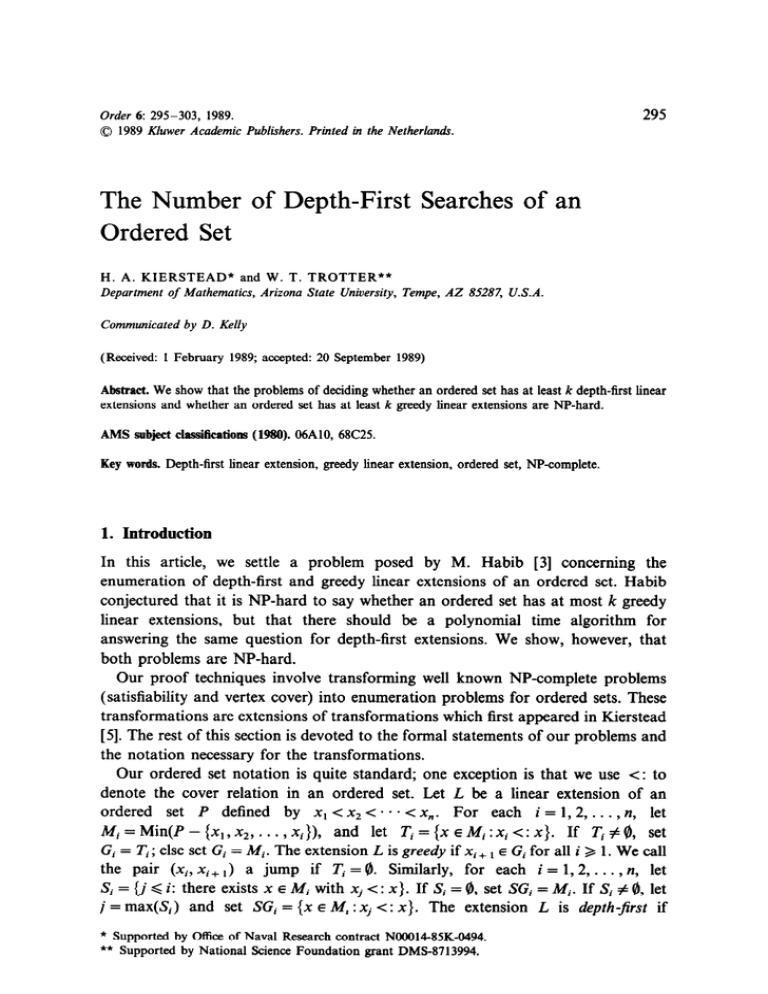
Order 6: 295-303,
1989.
0 1989 Kluwer Academic
295
Publishers.
Printed
in the Netherlam&.
The Number of Depth-First Searches of an
Ordered Set
H. A. KIERSTEAD*
Department
Communicated
of Mathematics,
and W. T. TROTTER**
Arizona
State
University,
Tempe,
AZ
85287,
U.S.A.
by D. Kelly
(Received: 1 February 1989; accepted: 20 September 1989)
Abstract. We show that the problems of deciding whether an ordered set has at least k depth-first linear
extensions and whether an ordered set has at least k greedy linear extensions are NP-hard.
AMS
subject
chssi6catiom
(1980).
06A10, 68C25.
Key words. Depth-first linear extension, greedy linear extension, ordered set, NP-complete.
1. Introduction
In this article, we settle a problem posed by M. Habib [3] concerning the
enumeration of depth-first and greedy linear extensions of an ordered set. Habib
conjectured that it is NP-hard to say whether an ordered set has at most k greedy
linear extensions, but that there should be a polynomial time algorithm for
answering the same question for depth-first extensions. We show, however, that
both problems are NP-hard.
Our proof techniques involve transforming well known NP-complete problems
(satisfiability and vertex cover) into enumeration problems for ordered sets. These
transformations are extensions of transformations which first appeared in Kierstead
[5]. The rest of this section is devoted to the formal statements of our problems and
the notation necessary for the transformations.
Our ordered set notation is quite standard; one exception is that we use <: to
denote the cover relation in an ordered set. Let L be a linear extension of an
ordered set P defined by x,<x,-c~~~<x,.
For each i=l,2,...,n,
let
Afi = Min(P - {xi, x2, . . . , xi}),
and let Ti = {X E Mi : Xi <I x}. If Ti # $3, Et
Gi = Ti ; else set Gi = Mi. The extension L is greedy if xi + , E Gi for all i > 1. We call
the pair (xi, xi+ ,) a jump if Ti = 8. Similarly, for each i = 1,2, . . . , n, let
Si={j~i:thereexistsxEMiwithxi<:x}.IfSi=8,setSG,=M,.IfSi#0,let
j = max(&) and set SG, = {x E 44, : xi < : x}. The extension L is depth-$rst if
* Supported by Office of Naval Research contract NO001485K-0494.
l * Supported
by National Science Foundation grant DMS-8713994.
296
H. A. KIERSTEAD
X ItI
E SG, for all i > 2. We shall show that the following
NP-hard.
AND
W. T. TROTTER
counting problems are
Greedy Linear Extensions (GLE):
Instance: Ordered set P, positive integer k.
Question: Does P have at least k greedy linear extensions?
Depth-just Linear Extensions (DLE):
Instance: Ordered set P, positive integer k.
Question: Does P have at least k depth-first linear extensions?
Finally we introduce two well-known NP-complete problems that will be needed for
our proofs. Let U = {u, , . . . , u, } be a set of Boolean variables. A truth assignment
for U is a function f: U + {T, F}. If u E U then u and ii are literals over U. The
literal u is satisfied byf when f(u) = T; the literal ii is satisfied by f when f(u) = F.
A clause C over U is a set of literals over U. The clause C is satisjied by f when some
literal in C is satisfied by f. A collection of clauses S is satisfiable when there exists
a truth assignment which satisfied every clause in S. The next problem is the
original NP-complete problem of Cook [I].
Satisjability (SAT) :
Instance: A set U = {u,, . . . , U, > of variables
S={C1,...,Cn}
over U.
Question: Is S satisfiable?
and a collection
of clauses
Let G = (I’, E) be a graph. A vertex couer of G is a set C of vertices such that
every edge has at least one end point in C. Karp [4] showed that the next problem
is NP-complete.
Vertex Cover (VC):
Instance: A graph G = (V, E) and a positive integer c < 1VI.
Question: Does G have a vertex cover of cardinality at most c?
2. The Proofs
THEOREM 1. Depth-Jrst linear extension is NP-hard.
Proof. It suffices to show that we can transform the NP-complete problem SAT
to DLE in polynomial time. Let U = {ui, . . . , u,} be a set of variables and
S={C,,...,
C,} be a set of clauses over U, which form an arbitrary instance of
SAT. We shall construct an ordered set P and an integer k such that S is satisfiable
if and only if P has at least k depth-first linear extensions. For each variable ui,
there is a truth setting component W, of P. A typical truth setting component is
shown in Figure 1.
The truth setting components are linked together to form the stack by letting vi+,
and Ui+, cover w,. The point w, is called the top of the stack.
DEPTH-FIRST
SEARCHES
291
Fig. 1. Typical truth setting component W,.
For each clause C’, there is a satisfaction testing component Di of P. A typical
satisfaction testing component is shown in Figure 2. The exact value of the
parameter I will be determined later in the proof.
The satisfaction testing components are called combs. The elements sj, . . . , s;
form the spine of the comb Dj; the elements tj’, . . . , tJ are the teeth of the comb.
The element sj = si is called the base of the comb; rj is the root of the comb. The
satisfaction testing components are linked to the stack by letting the base of each
comb cover the top of the stack; furthermore for each literal x, r, covers x if and
only if x E C,. The transformation is completed by letting k = (r!)“. Figure 3 shows
the transformation
from S = {C, , C,}, where Cr = {u, , u2, z&} and C, =
(4, 6, e>.
The theorem follows from the next two lemmas.
LEMMA 2. S is satisfiable if and only ifP has a depth-$rst linear extension in which
the top of the stack w,,, precedes the root of every satisfaction testing component.
Proof. First note that for each i, one of U, and iii must precede w, in any
depth-first linear extension L. To see this, observe that vi and Vi are both less than
w,,,. If vi precedes fizin L, then v, must be covered by ui in L. Similarly, if fii precedes
vi in L, then fii is covered by Ui in L.
Suppose L is a depth-first linear extension in which w, precedes every root. Let
f be the truth assignment defined by f(q) = T when Ui < ui in L. Consider an
Fig. 2. Typical satisfaction testing component D,.
298
H. A. KIERSTEAD
Fig.
AND
W. T. TROTTER
3.
arbitrary clause C,. Since w, precedes rj in L, some literal x E C, is preceded by w,.
Thus, X c x in L,f(x) = T, and f satisfies C,.
Now suppose that f: U + {T, F} is a truth assignment that satisfies S. Let L be
the linear order defined by
where y, = U, and z, = ui if f(q) = F and yi = 17~and zi = U, if f(ui) = T. L is clearly
an initial segment of a depth-first linear extension of the stack. Since f satisfies S,
no roots must (or can) be taken before w,. Thus, L is an initial segment of a
depth-first linear extension of P in which the top of the stack precedes every root.
DEPTH-FIRST
299
SEARCHES
LEMMA 3. P has at least (I!)” depth-$rst linear extensions if and only if P has a
depth-jirst linear extension in which the top of the stack w,,, precedes the root of every
satisfaction testing component.
Proof. Suppose L is a depth-first linear extension of P such that no root is
less than w, in L. Then all the spines of the combs are between w, and all the
roots and thus precede all the teeth of the combs in L. Thus, the teeth of any comb
form an interval of L which is immediately preceded by the root of the comb.
Moreover, any reordering of any of these interals of teeth leaves a depth-first linear
extension. Since there are n intervals of r teeth, P has at least (r!)” depth-first linear
extensions.
Now suppose P has no depth-first linear extension in which w, precedes all the
roots. A comb is said to be exposed if its root precedes the top of the stack;
otherwise it is protected. The spine together with the teeth of an exposed comb, the
spine of a protected comb, and the teeth of a protected comb all form intervals in
any depth-first linear extension of P. Partition P into the stack S, the roots R, the
exposed combs together with the spines of the protected combs E, and the teeth of
the protected combs F. Let K, be the set of depth-first linear extensions in which
exactly i roots precede the top of the stack. We bound the size of Ki in two steps.
We shall show that a depth-first linear extension of P can order
(1)
(2)
(3)
(4)
S in
R in
E in
Fin
at
at
at
at
most
most
most
most
4” ways,
n! ways,
n!(Y’)‘,
and
(n - l)!(r!)“-‘.
Then we show that there is at most one way for a depth-first linear extension to
merge
(5) R with S,
(6) E with RuS, and
(7) F with RuSuE.
Suppose that we have shown (l)-(7).
Then IKi( < 4”(n!)*2(‘-‘)‘(n
- i)!(r!)“-‘.
Since i 2 1 and 2’- i < r!, this quantity is maximized when i = 1. Setting s = m + n,
we get IK, 1d 2’(r!)“- ‘(s!)~/Tz. Thus, summing over i = 1, . . . , n, we see that P has
at most T(~!)“-‘(s!)~
depth-first linear extensions. If we choose r > 3s, then
r! > 2’(s!) and so 2’(r!)“- ‘(s!)~ < (r!)n. Thus P has fewer than (r!)n depth-first linear
extensions.
It remains to show (l)-(7).
(1) The stack is made up of m truth setting components. Each can be ordered in
exactly four ways by a depth-first linear extension of P:
vi<u,<17,<<i<w,,
or
Vi<U,<U,<Wi<iii.
fi,<ii,<Vi<Ui<Wi,
vi < ui < fii < wi < tii
300
Also, there is a unique way for a
setting components: w, must be
{x, : x, E W, and wi precedes xi, for
if i >j. Thus, there are 4” possible
H. A. KIERSTEAD
depth-first linear
covered by the
some i} must be
orderings of the
AND
W. T. TROTTER
extension to merge the truth
least element of W,, , and
ordered by x, < xj if and only
stack.
(2) Trivial.
(3) There are n! ways to order the bases of the combs. Once the base of a protected
comb is chosen, the spine must be taken immediately in order of the superscripts.
When the base of an exposed comb is taken, both the spine and teeth must be taken
immediately. There are 2’- ’ ways to do this: Each time a nonmaximal element of
the spine sj is chosen there are two choices. The next element can either be sj+ ’ or
tj. If tf is chosen, then the next element must be s;+ ‘. After choosing sJ the
remaining teeth must be taken in reverse order of their superscripts. Since there are
i exposed combs, there are n!(2’- ‘)i possible extensions.
(4) There are n - i protected combs, which can be ordered in (n - i)! ways. The
teeth of a protected comb must be chosen immediately after the root of the comb.
There are r! ways to do this for each of the n - i protected combs. Thus there are
(n - i)!(r!)” - ’ possible extensions.
(5) Each root r, must come between the last literal of C, to be chosen and the next
element of the stack. Thus there is at most one way to merge R with S.
(6) The base of each spine must come between the top of the stack and any other
element of R u S. Thus there is at most one way to merge E with R u S.
(7) The teeth of each protected comb must come between the root of the comb and
any other elements of R u S u E. Thus there is at most one way to merge F with
RuSuE.
0
THEOREM 4. Greedy linear extension is NP-hard.
Proof. We shall transform VC to GLE in polynomial time. Let the graph
G = (V, E) and the positive integer c form an arbitrary instance of VC. We shall
construct an ordered set P and a positive integer k such that G has a vertex cover
of size c if and only if P has at least k greedy linear extensions. P is constructed in
two steps. First let P’ be the ordered set on Vu E u {x} such that ( 1) for any vertex
u and edge e, u < e if and only if v is an end point of e and (2) x covers every vertex.
For each edge e, let the ladder L, be the product of a two element chain with an r
element chain as shown in Figure 4. The parameter r will be determined later in the
proof.
The ordered set P is formed from the ordered set P’ and the ladders {L, : e E E}
by identifying af with e and letting ba cover x, for all edges e. We complete the
transformation by setting k = (Jr + c - l)!/(r!)“, where 2 = IEl - c + 1. Figure 5
shows the ordered set which corresponds to P3, the path on three vertices, when
r = 4.
The theorem follows from the next two lemmas.
DEPTH-FIRST
301
SEARCHES
bt
Fig. 4. The ladder 15~.
LEMMA
5. G has a vertex cover of size at most c if and only if P has a greedy linear
extension which puts at least A edges over x.
Proof. Suppose C is a vertex cover of size at most c. Form a greedy linear
extension of P by first choosing the vertices of V - C. This is possible since all edges
cover a vertex in C, which has not yet been chosen. Choose the remaining points of
the greedy linear extension by avoiding edges wherever possible. After choosing a
vertex from C we may be forced to then take an edge, but we will never be forced
to take more than one edge. After choosing the last vertex from C, we can avoid
taking an edge by choosing x. This leaves at least 1 edges to be chosen after x.
Now suppose L is a greedy linear extension of P, which puts at least 1 edges over
x. Let C = {v E V : v < : y in L, for some y E E u {x>>. Clearly ICI < c. To see that
C is a vertex cover, consider an edge e = VW.Suppose v < w in L. When w is chosen
Fig. 5.
302
H. A. KIERSTEAD
AND
W. T. TROTTER
e is minimal among the remaining elements and covers w. Thus e covers w in L
unless some other edge or x covers w in L. In either case w E C.
0
LEMMA 6. P has at least k greedy linear extensions if and only if P has a greedy
linear extension which puts at least II edges over x.
Proof. The chain {bi , . . . , b: } is called the upper chain of L, ; the chain
d = IDI, and A4
{d,. . . , a:} is called the lower chain of L,. Let D = VuEu(x},
be a linear extension of D. An edge e is said to be exposed in M if e precedes x in
M; otherwise e is protected in M.
Suppose P has a greedy linear extension M, which puts at least 1 edges above x.
Let R = {ad. . e is protected in M} u {b f : e is exposed in M}. Then IR I= Ir + c - 1
and there are k = (Ar + c - l)!/(r!)” linear extensions of R. Each linear extension L
of R is contained in a greedy linear extension of P formed as follows: Let M, be M
restricted to {y : y < x in M} and L+ be L with bb inserted immediately after a:, if
e is a protected edge, and the rest of the upper chain of L, inserted immediately
after bl, if e is an exposed edge. Then M, + L + is the desired greedy linear
extension of P. We conclude that P has at least k greedy linear extensions.
Suppose no greedy linear extension of P puts all but c - 1 edges above x. Fix a
greedy linear extension M of P. Let H = {a: : e is exposed in M} and K = u {L, : e
is protected in M} u (b: : e is exposed in M}. We shall show that greedy linear
extensions of P, which agree with A4 on D, can order
(1) DuHin
at most one way and
(2) K in at most r”-‘[r@. - 1) + c]!/(r!)“-’
ways.
Suppose we have shown ( 1) and (2). Then the number of greedy linear extensions
which is less than k = (Ar + c - l)!/
of P is at most d!r’- ‘[r(A. - 1) + c]!/(r!)“-‘,
(r!)‘, when we set r = d In(d).
It only remains to show (1) and (2).
(1) If e is exposed in M, then the lower chain of L, must be chosen immediately
after e in any greedy linear extension of P.
(2) Note that if for some edge e, a: is covered by af+ ’ in a greedy linear extension
L of P, then for all j 2 i, aJ, is covered by a:+ ’ in L. Thus, if e is a protected edge,
then L, can be ordered in r ways, each with at most r jumps, by greedy linear
extensions of P. If e is an exposed edge, the upper chain of L, must be chosen
immediately after bb in any greedy linear extension of P. There are at most A - 1
protected edges in P. Thus, there are at most r’- l ways to order the parts of
ladders, which are contained in K, and [r(A - 1) + c] !/(r!)’ - ’ ways to merge these
0
parts in a greedy linear extension of P. The result follows.
References
1. S. A. Cook (1971) The complexity
Theory of Computing,
Association
of theorem
of Computing
proving
procedures,
Machinery,
New
Proc. 3rd Ann. ACM
York,
pp. 15 1 - 158.
Symp.
on
DEPTH-FIRST
SEARCHES
303
2. M. R. Garey and D. S. Johnson (1979) Computers
and Intractability:
A Guide to the Theory of
NP-Completeness,
Freeman, San Francisco.
and Order (ed. I. Rival), Kluwer Academic Publishers,
3. M. Habib (1988) Problem 4.2, in Algorithms
Dordrecht.
4. R. M. Karp (1972) Reducibility among combinatorial problems, in Complexity
of Computer
Computations (eds. R. E. Miller and J. W. Thatcher), Plenum Press, New York, pp. 85-103.
5. H. A. Kierstead (1986) NP-Completeness results concerning greedy and super greedy linear extensions, Order 3, 123-134.
